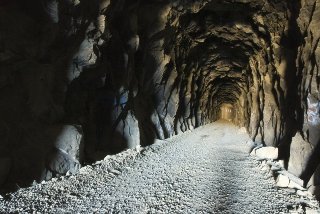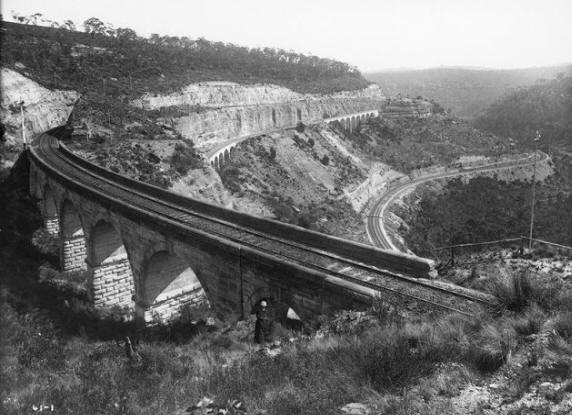Jerrems Family Newsletter
Dear Donald,
together long ago. Improved transcontintal
transportation systems become part of the family lore.
Enjoy Ray’s account below.
Place your mouse cursor over the image to view
the caption text.
Every December we try to offer greeting to each other
through the journal.
This year we plan to send images of old family
Chrismas cards…the ones with family photos at the
time.
Recently, I found one from our 1948 family. I plan to
use it in the December issue. If you have one you
would like to include, digitally scan it and send me a
copy.
| A Tale of Two Railways |
Ray Jerrems, Our Genealogist, Historian
Connections by Railway

Introduction
Recently I have been reading about the history of the
construction of railways in the United States, for two
reasons. The first reason is that I have been very
interested in railway history in New South Wales since
I was a small boy (for reasons I will talk about later in
this article), so it seemed logical to compare it with the
railway history of the United States. The second
reason is that it forms a backdrop to the history of
parts of the Jerrems families in New South Wales and
the US.
Melbourne readers have the picturesque “Puffing Billy”
railway line which climbs up the Dandenong Range
from Emerald, but as far as I know this railway does
not have any specific relevance to the Jerrems
families of yesteryear.
Readers like Sue Jerrems, who has a miniature
steam train line in her garden in Los Vegas (plus a
Pullman car and a caboose), will particularly
appreciate this article. But I am sure that everyone
else will enjoy it too.
I dedicate this article to Jerry lV (William George
Jerrems lV), Sue’s late husband and a fellow steam
train enthusiast.
The New South Wales family’s
railway connection.
Briefly, my interest as a boy in the history of railways in
New South Wales was piqued by accounts from my
grandparents of their train trips across the Blue
Mountains (to the west of Sydney) in the late 1800s. In
those days the railway was a single track railway
which had the famous “Zig Zag” (pictured
above) at the western end of
the Blue Mountains to enable it to descend the
western escarpment. My grandfather Alf Jerrems
lived
in Sydney, and my grandmother Esther grew
up in
Lithgow, a short distance beyond the Zig Zag. In their
courtship days they travelled a lot along this route by
train to see each other, and after they married in 1905
and settled in Sydney they continued use the railway
on occasions to visit the numerous Lithgow relations.
If the Zig Zag hadn’t been built my grandparents would
never have met and I would not be writing this article
today.
I will tell you more about the remarkable “Zig Zag” after
telling you about the US connection.
The United States family’s railway connection
The United States family’s connection with railway
history is also interesting. When William George
Jerrems (my grandfather’s uncle, and Jerry lV’s great
grandfather) and his young family sailed from
Sydney to San Francisco in about 1876 they would
have travelled to New York by train, along the recently
opened Transcontinental Railroad (using a generic
term for it). A spectacular feature of this railway,
comparable with the Blue Mountains Zig Zag, was the
way it climbed from Sacramento over the Sierra
Nevada Range through the legendary Donner Pass.
Like the Zig Zag, the Donner Pass section of the
Transcontinental Railroad had been described at the
time as one of the world’s major engineering feats. A
big difference between the two railway journeys was
that it took five hours to travel from Sydney to Lithgow
and at least five days to travel from San Francisco to
New York.
In later years William and his father-in-law
Alexander Nicoll opened “Nicoll the Tailor”
stores in San Francisco and Sacramento, so they
would also have travelled along this railroad on a
number of occasions.
If there had not been a railroad from San Francisco to
New York when the family landed in San Francisco
then perhaps our editor Donald’s great grandparents
may have settled in San Francisco and (like me)
Donald would not be editing this Journal.
The Zig Zag Railway
Now known colloquially as the Zig Zag Railway, the
first railway over the Blue Mountains was commenced
in 1866 and completed in 1869. Its significance was
that it opened up railway access to the vast area of
western New South Wales, replacing rough roads
used by slow horse carts, horse coaches and bullock
wagons.
To understand the meaning of the term “zig zag” you
need to imagine a road descending a steep mountain
using a series of “hairpin bends”, but replace the
bends with overruns where the trains stopped and
then reversed down the next section, then forward
down the next section. Then put in long stone arched
bridges to cross the gullies in between.
In some parts of the “Zig Zag” section workmen had to
be lowered down the cliffs to drill holes for blasting,
and in one instance 2 tons blasting powder was used
to remove 45,000 tons of rock in one huge explosion.
A party of dignitaries travelled up from Sydney for the
occasion, and the explosion was set off by the State
Governor’s wife.
In fact the railway descended a total of about 1000 feet
into the valley (not a lot compared with the United
States Trans Continental Railway) from the top of the
range at Clarence Tunnel. For the most part its fame
was probably due to the novelty and ingenuity of its
construction and its huge impact on the opening up of
western New South Wales, rather than the immensity
of the work carried out.
The Zig Zag part of the railway became rather
notorious for trains running away on the steep
gradients, mainly involving goods trains. When there
was a pile-up the townspeople of Lithgow (including
my grandmother) flocked along to look at the results.
On one famous occasion a steam engine crashed
through the buffers and almost toppled over a high
cliff. Luckily its progress was arrested by rocks before
it overbalanced.
This section was replaced by tunnels in 1910, ending
an era.
The United States Trans Continental Railway
I have used the term “Trans Continental Railway” for
ease of reference (it was called the Central Pacific
and the western part was owned by the Union Pacific
Company, which gets complicated). Its significance
was that it opened up railway access between the
eastern and western coasts of the United States,
replacing (a) a long and dangerous trip by wagon train
across the United States (b) a laborious sea voyage
from the East Coast around the bottom of South
America and up the West Coast to San Francisco or
(c) a boat trip on the East Coast down to the Panama
area, a land trip across to the other side, and a further
boat trip to San Francisco (these were the routes used
in 1849 by the “Forty Niner” gold miners to get to the
gold fields near San Francisco).
Although the founder of the railroad, Theodore Judah,
first conceived a practical plan for the building of such
a railway in 1860 it took him several years of
intermittent exploration to work out how it could
actually ascend the San Francisco side of the Sierra
Nevada Mountains, near San Francisco. He finally
chose a route across Donner Pass, previously used
by settlers’ wagons. This part took a small army of
workers five years to construct, and involved very steep
gradients up a winding route, and the construction of a
complex system of cuttings, bridges and tunnels.
In
1869 the railway was opened along its full length with
great fanfare.
In one section the ascent route to Donner Pass
wended its way along the rim of the American River
Canyon, in some cases 2000 feet above the river.
Starting near Sacramento almost at sea level the
railway climbed to a little over 7000 feet (2134
metres), a huge climb for the small steam engines
used in those days. For the benefit of Australian
readers the Pass was almost as high as our highest
mountain, Mount Kosciuszko.
The winters were severe on the heights of the range,
raising unexpected problems of winter snowfalls.
Eventually a total of 30 miles of “snow sheds” were
built over the high sections to keep the snow off, and
snow plough teams were kept on standby.
Although the Donner Pass was one of the highest
railway routes used in the United States, it was by no
means the highest. This honour goes to the Alpine
Tunnel on the narrow gauge South Park Line in
Colorado, at nearly 12000 feet (3658 metres). Opened
in 1882, it was closed in 1910 because it was
impossible to keep open due to high snowfalls.
The Donner Pass section of this railway was
superseded in the 1990s by a tunnel.
The engines used on the US Transcontinental
Railway and the Zig Zag
The engines used by our relatives in 1876 (in the US)
and in the very early 1900s (the Zig Zag) were quite
different, primarily because the engineering had
improved significantly in the intervening period.
In the United States a particular design was used
from the 1850s well into the 1880s, involving a wheel
configuration of 4-4-0 (4 small wheels at the front, 4
connected big wheels in the middle, and none under
the cab), known in the USA as the “American”. Similar
designs were used in New South Wales at the time
also. It is this type of locomotive that would have
hauled the Jerrems family’s train in 1876, with the
assistance of an additional engine up the steep
grades to Donner Pass.
The brightly coloured trains of this era, with their large
timber cabs, polished funnels and large head lamps
and cowcatchers, probably reflected the romance of
the period.
By the mid 1890s in New South Wales the more
sedate-looking P6 (later renumbered as the “32
Class”) was hauling trains over the Blue Mountains.
This was a more powerful loco with a 4-6-0
configuration, having 6 smaller connected wheels in
the middle. These engines would have hauled the
trains used by my grandparents, assisted on
occasions by another engine “double heading” on the
front.
Memories
Hopefully you have some restored steam trains which
operate occasionally in your area, or there are
miniature steam trains there, to remind you of the
marvellous days when steam trains reigned supreme.
Or perhaps you have a small grand daughter named
Jessica (as I have) who has a toy steam engine which
has a whistle which sounds just like a steam train
whistle. It takes me back to the whistles I used to hear
echoing in the Blue Mountains when I was a boy, and
to my grandparents who would have done likewise.
No doubt you have memories also.
The caboose/guard’s van has arrived
When you are watching a steam-hauled goods train
passing by, you know when the end of the train is
getting close because you see the caboose
approaching (in the United States) or the guard’s van
approaching (in Australia). The caboose/guard’s van
has arrived for my article and it is time for me to sign
off.
It has been interesting to see how two of the best
known railways in the world had a connection with the
Jerrems family, and that without these railways
perhaps many of us would not be here today.
| Image Old Engine |

| Image Old Tunnel |


